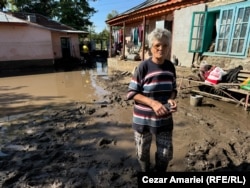At nearly 3 a.m. on a Saturday last month, 61-year-old Stefana Bodea was jolted awake by a clamor outside in Slobozia Conachi, her otherwise sleepy district nestled among carefully plowed fields astride the Suhurlui Creek in eastern Romania.
She could hear the bells of the Orthodox church, the roar of a civil siren from the local school, and, distinctly, the urgent shouts of Mayor Emil Dragomir outside her gate, telling everyone inside to get out immediately.
"He was saying that very bad water was coming," Bodea told RFE/RL's Romanian Service. Within 15 minutes, Bodea said, the water was up to her chest.
"We climbed into the attic," she said, where with her son and a niece she waited nine hours before being plucked from an open window with a tractor.
Bodea's was one of dozens of communities in eastern Romania and other low-lying areas of Central Europe that suffered catastrophic flooding from Storm Boris on September 13 and 14.
There was no shortage of contributing factors to the flooding in her home county of Galati, which killed five people and destroyed or damaged 7,000 households over that 48-hour period. Experts say they include climate change, substandard flood defenses, unchecked development, and deforestation and degradation blamed on agriculture.
But for some of Galati's victims, the devastation stirred painful memories of a project left unfinished under communism and allowed to deteriorate for three decades despite warnings of looming disaster: the Suhurlui Dam.
Water-management experts and former local officials agree that if had been completed, Suhurlui would have mitigated three bouts of severe flooding in the past decade -- and almost certainly saved thousands of homes last month in Galati.
Ceausescu Era
The Suhurlui Dam was one of four major irrigation projects conceived by Romanian dictator Nicolae Ceausescu's government to transform the country's agricultural sector. Known collectively as the Covurlui irrigation project, they were launched in the early 1980s with $315 million (about $1.2 billion in today's terms) in World Bank lending.
Covurlui was designed in large part to provide key drainage and overflow facilities that could control erosion, encourage soil regeneration, and help irrigate 650,000 hectares of the croplands north and west of the Danube Delta. But, crucially, it was also supposed to reduce the risk of the kind of flooding that climate scientists warn are a symptom of a warming planet.
The Ceausescu regime backed out of the Covurlui venture in 1982, before finally repaying its related debts to the World Bank in 1984 with the project about 28 percent complete.
Work continued until 1994, with hundreds of workers manning unfinished infrastructure and a specially constructed railway that ran from quarry to embankment.
"That dam should be strengthened," Gigi Turu, the mayor of the district of Suhurlui for two decades, told RFE/RL recently. "We could have directed the upstream water in a controlled way...[but] it wasn't done and look what happened."
According to Costel Fotea, the president of the Galati County council, local councils don't have the power to intervene to regulate the riverbeds or the river flow.
Disaster Mitigation
Sorin Randasu, director of emergency situations for the Romanian Waters National Administration, said last month that Suhurlui was listed as a priority project in EU flood-risk management plans a decade ago and should be redesigned with a higher capacity. Speaking to RFE/RL, Randasu acknowledged that, if completed, the project would have reduced the impact of such disasters. "Even now, the unfinished works have mitigated the flooding," Randasu said.
That is little consolation to Danut Popa, who once worked on the unfinished dam that's just a few hundred meters from his home in Suhurlui. "That's where the water was," he said of last month's flooding, putting a hand to his chest. There was nothing he could do for his chickens, he said, most of which drowned. But he saved six piglets: "I swam with them in my arms, just like in the movies."
Since construction was halted, the abandoned dam has become a testament to neglect and bureaucratic inaction. Thieves have scavenged materials and equipment like clay carts and trailers from the site, says Gheorghe Buruiana, who was mayor of Rediu, which used to include Suhurlui.
Efforts to revive the project have been further complicated by the sale to private owners of land where the reservoir was supposed to stand, he says.
Radu Drobot, a professor of hydrotechnical engineering at the Technical University of Civil Engineering in Bucharest, said the Suhurlui Dam could play "an extremely important part" in flood prevention. If it were in place, he says, downstream flows could be reduced by around 80 percent.
Rebuilding
In the face of a rising tide of disaster, Mircea Fechet, Romania's environment, waters, and forests minister, said on September 25 that he had ordered a feasibility study "within a record period of time" for redeveloping Suhurlui with a greater focus on flood protection than irrigation. But even a fast-tracked study will take months to complete, and years to implement the results.
For Slobozia Conachi resident Stefana Todica, that's a lot of uncertainty on which to rebuild her life. A few pots and some clothing are all she has after Storm Boris, she told RFE/RL -- everything else was bloated or otherwise destroyed. She hoped to get a container that could provide some shelter, but that presents its own challenges in a region where winter temperatures can drop to minus 20 degrees Celsius.
While she stood surveying the damage, Romanian authorities were declaring red alerts and evacuations as heavy rains and flooding threatened Galati again on September 30-October 1.











